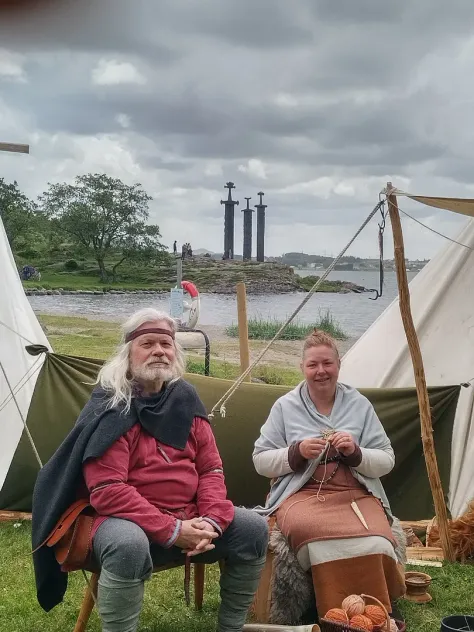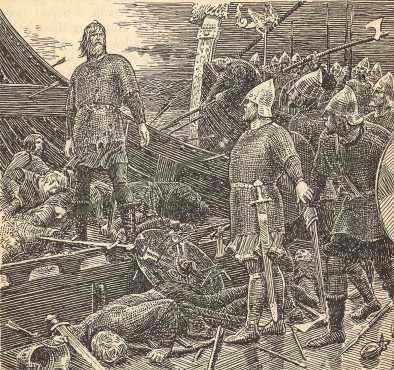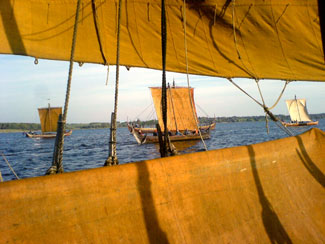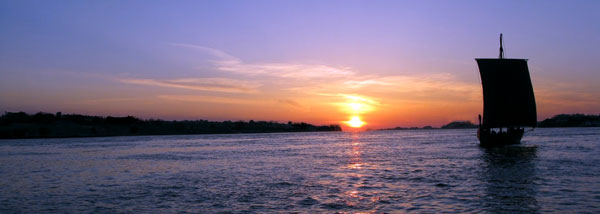

Me playing Viking in Norway, at the Hafrsfjord Festival in 2022, with the president of the Karmoy Viking Club.
[Updated 2024] I included a short essay on the Vikings in this space when this site was first established. But the world moves on, and I find that piece (you can find it below this one) no longer addresses the current situation. My views have changed very little, but I think I need to explain them in a new light.
When I wrote the original essay, back before the turn of the century, the prevailing scholarly view of the Vikings (a view considered "revisionist" at the time) was that the violence of Viking culture had been exaggerated by monkish scribes, "prejudiced" because Vikings kept burning down their homes and enslaving or killing them (which strikes me, personally, as a reasonable excuse for a prejudice). The prevailing view in the late 20th Century was that the Vikings (viewed as a culture, rather than as participants in an activity, which was the original sense of the word) were primarily involved in trade, and that their occasional ventures into raiding (mostly in response to the inflexible attitudes of the vile Christians) were relatively rare and reasonably justified.
I thought this view nonsense. I noted that the purveyors of this theory tended to gloss over the fact that the Vikings' first and foremost item of trade, at least in the first centuries, was human slaves. Call me old-fashioned, but I don't consider the slave trade a peaceful occupation.
But the other day I watched, for the second time, Robert Eggers' 2022 film, "The Northman." I can only conclude, based on that movie, that I've won the "peaceful Vikings" argument completely. Perhaps I've won it too well. Eggers' Viking culture is thoroughly violent and brutal. Force is all that matters there, and the individual must either possess power or submit to it.
This view strikes me as just as unbalanced as the old one. It overlooks (as Prof. Jackson Crawford has noted) the importance in Viking culture of being a "drengr," a man of honor and character. In the movie, for instance, the ball game of "knattleikr" is played by thralls (slaves), and fatalities are considered trivial, since thralls are cheap (note: they were not cheap). In the Icelandic sagas, however, free men play knattleikr themselves, in order to showcase their courage and skill.
This narrow view also overlooks the Vikings' democratic tradition (emphasized in Viking Legacy, the book by Torgrim Titlestad which I translated). The Vikings in fact mistrusted raw power, and mitigated it through limiting their kings under the law, subjecting royal decisions to the "Thing" assemblies of free men. Viking society was far from egalitarian, but they revered law, cherishing it as fundamental to a functional society. They cared, in their own way, about freedom - for themselves, anyway. (This is the human norm, by the way - the concept of the brotherhood of Man came to us from Christianity, and has been internalized slowly, even among Christians.)
Why this radical change in popular views of the Viking Age? I think it rises from the political climate. Scholarly opinion in our time is the obsequious servant of politics. (Perhaps it always has been. The current academic fascination with intersectional power may be plain projection.)
For most of my lifetime, the North Star, the guiding principle, of this Political/Scholarly-Industrial Complex has been contempt for Western Civilization. When Vikings were viewed as outsiders to that civilization, scholars had to regard them positively. Now that they have come to be viewed, sometimes, as insiders, the original Dead White Males, they can be despised - when convenient.
The truth of the Vikings is that they were like everyone else. They lived the best way they knew how, according to their lights. (Snorri Sturlusson understood this in the 13th Century. Moderns are often less sophisticated.)
In my view, one major point that's generally overlooked in our discussions of the Vikings is that the Viking Age was the Scandinavian Age of Conversion. When the Vikings first hit Lindisfarne in 793 AD, they were mostly heathen (though missionary activity had probably begun even then). By the (generally accepted) end of the Viking Era - the Battle of Stamford Bridge in 1066 - the Danes and Norwegians were solidly Christian and the Swedes not far behind. One of the chief reasons for the end of Viking activity was a nascent internalization by Scandinavians of the Christian ethic - an ethic they still haven’t entirely embraced - like everyone else.
There's another point too. That point - a major one, though intellectually disreputable - is the element of fun. When I fell in love with the Vikings as a boy, it was the image of a dragon ship under sail, headed off to adventure, that gripped me. An idea formed in my mind of a bold hero at the prow of such a ship, a free man sailing out to test his courage and seize his fortune. That image - in time - coupled with the historical figure of Erling Skjalgsson and gave birth to my series of historical fantasy novels, The Year of the Warrior, West Oversea, Hailstone Mountain, The Elder King, King of Rogaland, and The Baldur Game.
Robert Eggers' movie contains not one moment of that kind of fun. I hope my Erling books do a better job.

[Original essay referenced above] There are two things everyone is required to say nowadays when discussing the Vikings.
- The Vikings did not wear horns on their helmets. The idea of horns comes from costume designers for Wagnerian operas, who picked up the idea of horns from images in certain decorative items found in Northern European archaeological digs. These images, however, are older than the Viking Age, and almost certainly represent priests in ceremonial dress. Horns on helmets are an incredibly bad idea in a fight. They give your enemy a lever to knock your helmet off with.
- Although the Vikings are commonly thought of as violent barbarians, they were really farmers and merchants, and no more violent than anyone else in their time. Because they attacked monasteries, the monks who were that age’s chroniclers left biased reports about them to posterity.
My own opinion of these two statements above is that Number One has been repeated so many times that it shouldn’t be necessary anymore (though I’m constantly surprised at how many people don’t know about it). As to Number Two, in my opinion it’s a half-truth at best, a political and philosophical statement rather than a historical fact.
In the past European history was written with a bias towards Christianity and Western Civilization. That bias has gone out of fashion. Today the bias goes the other way. Christianity is oppression. Western Civilization is all about racism. From this point of view anyone who fought against Christian Europe must be a hero or a victim. Under this scenario the Vikings become the good guys, the monks the oppressors and aggressors.
There is much to admire in Viking life and culture. I’ve spent more than 40 years of my life studying them, so obviously I don’t despise them. They practiced a form of democracy, lived by a heroic code of honor, gave their women rights that other women in
 On the other hand, their democracy was constructed on oligarchic lines, and all men were far from equal, especially thralls (slaves). Their heroic code of honor led to blood feuds and long cycles of retribution. Their women (in my opinion) were not nearly as emancipated as is often implied by historians. A woman, for instance, could inherit a chieftainship but was not allowed to actually exercise it, because women weren’t considered capable of the kind of violence the job required. Their inheritance rights actually increased after the conversion to Christianity, for the pragmatic reason that the Church discovered they were more likely than men to make gifts of land to the Church, providing they had land to give. This made the Church their constant advocate in matters of property and inheritance law. A survey of Viking Age female skeletons from all over
On the other hand, their democracy was constructed on oligarchic lines, and all men were far from equal, especially thralls (slaves). Their heroic code of honor led to blood feuds and long cycles of retribution. Their women (in my opinion) were not nearly as emancipated as is often implied by historians. A woman, for instance, could inherit a chieftainship but was not allowed to actually exercise it, because women weren’t considered capable of the kind of violence the job required. Their inheritance rights actually increased after the conversion to Christianity, for the pragmatic reason that the Church discovered they were more likely than men to make gifts of land to the Church, providing they had land to give. This made the Church their constant advocate in matters of property and inheritance law. A survey of Viking Age female skeletons from all over
The ships were really cool though.
The Vikings were the foremost European slave merchants of their time. When historians point to their trade activities as proof that they weren’t all violent, they often leave out the fact that a very large portion of that trade involved kidnapping and selling human beings. The Vikings harvested slaves from the Slavic tribes of

Since I’m a Christian, I feel that the pendulum has currently swung too far in the Vikings’ favor. Certainly the Christian kingdoms of
I think Vikings are exciting, and I enjoy playing a Viking with the Viking Age Club of the Sons of Norway when I get the chance.
But you know what? I wouldn’t want a real Viking to move in next door.